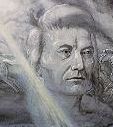To view this page in another language, please click here:
Other Languages
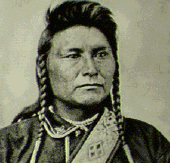
Chief Joseph, Nez Perce (Nimi'ipuu)
(Nee-Mee-Poo/hinmatowyalþhtqit)
"I am tired of fighting.... from where the sun now stands, I will fight no more.
Chief Joseph, as Remembered by Ohiyesa (Charles A. Eastman)
Chief Joseph, known by his people as In-mut-too-yah-lat-lat (Thunder coming up over the land from the water), was best known for his resistance to the U.S. Government's attempts to force his tribe onto reservations. The Nez Perce were a peaceful nation spread from Idaho to Northern Washington. The tribe had maintained good relations with the whites after the Lewis and Clark expedition. Joseph spent much of his early childhood at a mission maintained by Christian missionaries.
In 1855 Chief Joseph's father, Old Joseph, signed a treaty with the U.S. that allowed his people to retain much of their traditional lands. In 1863 another treaty was created that severely reduced the amount of land, but Old Joseph maintained that this second treaty was never agreed to by his people.
A showdown over the second "non-treaty" came after Chief Joseph assumed his role as Chief in 1877.
After months of fighting and forced marches, many of the Nez Perce were sent to a reservation in what is now Oklahoma, where many died from malaria and starvation.
Chief Joseph tried every possible appeal to the federal authorities to return the Nez Perce to the land of their ancestors. In 1885, he was sent along with many of his band to a reservation in Washington where, according to the reservation doctor, he later died of a broken heart.
Chief Joseph
by Brookie Craig BTRU93A@prodigy.comChief Joseph, was kept captive, never being allowed to return to his Nez Pearce Homeland even though General Miles promised he could live in Idaho. Chief Joseph is buried on the Colville Reservation in Washington and today I visited his grave to do ceremony.
The small village there consists of one gas station....very few houses and no businesses...very desolate in a unforgiving country of arid, desert surroundings. His grave sits on a small hill....surrounded by others of the People...most without headstones, but some with small rocks marking their final resting place.
I find him easily, sensing to know exactly where to go...and he is buried under the only tree in the cemetery....a sort of gnarled, broken, old, withered tree....A marker is there, furnished by Western Washington University in 1906, a few months after he died in 1905 at the age of 60, alone and forgotten by most of that time.
A sense of profound sadness captures me as I sit by the neglected grave of one of our People's greatest Leaders...Long ago items, now withered and decaying....left by those who do now remember his greatness, scattered in disarray, cluttering the ground in their glory to him.
Arrows..beads...plastic roses..feathers...strips of decaying cloths....a Colville Reservation emblem jacket, hanging on the tree...a bic lighter...many cigarettes stained by rains, or teardrops...a plastic water bottle....a priceless bone necklace draped on the tombstone...rocks....hand drawn pictures...private written messages held down by rocks....and countless coins, strewn all around broken vases holding stems of sage.
No one seems to clean up around it. It bothers me to know that this great leader is neglected as I sit caressed in the cool shadows of that ancient tree and I try to understand it all.
I notice that they even buried him facing West and not East towards his homeland....I weep...my tears joining countless unknown others who have felt the pain there. I tell him I hope he has found his peace....and the winds begin to come. Another there with me, who is watching from a respectful distance tells me later I have spoken aloud..."He is here."
The winds become stronger and he tells me later that they suddenly change direction, coming from the North...the direction they captured and brought him here from.
The light is dimming....I look up...and shade my eyes, looking over the horizon hills....seeing in my heart his figure on a pony. Silently I watch....and continue with the sage and cedar....and feel an overwhelming sense of sacredness like I have never felt before. I look up in the overhanging branches and see the long deserted birds nest...and the sky shows clear. Through its twigs I see the Nez Perce in their long retreat....fighting...struggling to reach freedom and asylum with Sitting Bull across the Border in Canada...for 105 days...always moving...700 people...women, children...elderly...walking 1,800 miles...only to be captured within 50 miles of their destination and freedom. Captured only because he was forced to surrender, refusing to leave the sick and dying of his People there, alone.
I remember that his tactics were so brilliant they are taught to this day at the U.S. Military Academy at West Point.....and as I clear the decay from the ground which holds him captive, my heart remembers his words, "From where this sun now stands, I shall fight no more forever."
I watch the sun leaving me....and the shadow of this warrior falls back into the mountains. I touch the ground which caresses him....and weep for a man who believed in the goodness of others....who wanted nothing more than freedom....who was so great that an entire People walked those tortuous miles in freezing sleet and snows... who was never allowed to see his home again....and these words come strong to my heart to share with you... spoken from that sacred place: "We live, we die, and like the grass and trees, renew ourselves from the soft clods of the grave. Stones crumble and decay, faiths grow old and they are forgotten but new beliefs are born. The faith of the villages is dust now...but it will grow again....like the trees. May serenity circle on silent wings and catch the whisper of the winds."
I turn and leave honor in my farewell as the shadows take him back....Now I shall miss him....even more.
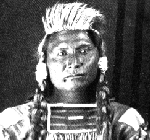
Harper's Weekly, August 16, 1890 Volume 34.
The remnant of the Nez Perces to which Joseph belongs are now on a portion of the Cherokee Reservation, purchased in 1878 from the Cherokees. It is a square containing about 91,000 acres, lying across the Salt Fork of the Arkansas River, just above that which was bought for the Poncas. They have the Poncas on the east, and the Otoes and Missourias on the southeast. Kansas lies well to the north, and one crosses the big Osage Reservation when approaching it from the eastward. After their capitulation to General Miles in 1877, the remnant of the tribe, numbering 431 souls, were taken to Fort Leavenworth, where the location of their camp was so unhealthy that they lost many by disease. They were removed to their reservation on the Salt Fork in 1879, whence it has been proposed to move them again, in pursuance of the hand-to-hand policy which has affected Cherokees, Osages, and other larger nations in their gradual removal to the West before the swarming settlers. It was probably because of business relating to the further removal of the Indians that Chief Joseph came within range of our sculptor, and found himself immortalized in clay. Though he had ridden hard for many days to reach head-quarters, the old chief was fresh and alert. But, curiously enough, he found that sitting for his portrait was quite a different task from sitting a horse. Mr. Warner says that it wearied Chief Joseph exceedingly, far more than it does white men who are much less vigorous.
The Nez Perces belonged in what is now the State of Idaho, and the greater part of the tribe remained on reservations in that Territory. A few years ago several thousands were flourishing in the northern part of the Territory, having farms, schools, and churches. Other accounts make them out as debased by drink and the vices of white adventurers. A minority of the Nez Perces never agreed to the cession of their lands, and occupied the army for some months at various times in making them submit. The name given the Nez Perces by the French coureurs de bois is singularly inappropriate, as they do not mutilate their noses, and seem never to have done so as a tribe, whatever may have been the fashion in some branch of their kindred. The Sahaptins, for example, who have given the name to a congeries of tribes including the Nez Perces, are said to have bored the nose in order to carry a nose ornament like the Hindoo women and some tribes of Brazil.
Chief Joseph calls himself Hin-mah-too-yah-lat-kekht, and the tribe is said to use Numepo as their preferred title, though nomenclature among Indians is a parlous thing, many names at the same time and different names at different epochs being the fashion with them individually and in the mass. He is a very high type of Indian as regards brains and courage, but he possesses many of the peculiarities of the savage. His eyes are dull and his features stolid as a rule, but if a bird passes, an animal makes a sound in the bush, an insect comes within earshot or eyesight, something happens in that vacant look. Things that we do not regard have hidden meanings to him, either in connection with the weather, or by reason of superstitions which link certain results with certain appearances, or because the sight of one animal or insect has to do with the presence or the absence of another. The sculptor says that only when some beast, bird, or insect was in sight did the old chief look the warrior and the Indian. When that was gone he relapsed into the apparently unthinking state of an animal, and showed very plainly that to remain in one position while the clay was modelling itself under the artist's fingers was a penance greater than to wait immovable for hours until game revealed itself or an enemy crept in sight.
Chief Joseph belongs to the light-colored Indians. As most people are aware, the native races vary in tint from a brown that approaches the blackness of a negro to a light coffee-color not so dark as many Europeans. The Quichuas of Peru are very black, and the Heidahs of Queen Charlotte and Blackfeet of the Saskatchewan are fair. The Pammas of Brazil are lighter than many Spaniards and Portuguese, while the Iroquois and Algonquin tribes are coppery or light brown. But what is often overlooked is the apparent unimportance of climate on the color of the Indians under the arctic circle or at the equator. Were it not for the broad plaits of hair and absence of beard, giving to Chief Joseph that curious resemblance, in our eyes, to an old woman which we see in so many Indians, the face might be that of a European. As heavy lips, as bent a nose, as high a cheek-bone, may be seen in any crowd of white men. The forehead is good, and the brain cavity ample. In sailors and woodsmen we find the same close-lipped, somewhat saturnine expression.
On the artistic side one may note how Mr. Warner has felt the building up of the cranium and jaw, and how strongly yet subtly he has modelled the texture of the face. From the inscription the marks of quotation might well be spared at the words Joseph and Nez Perce, while the word Indians itself might be criticised as redundant.
Chief Joseph, as we all know, had a claim to the Wallowa Valley in Oregon, dating from the Stevens treaty in 1855, and conceded again to him and his tribe of about 500 Indians in 1873 by General Grant, while the latter was President. Two years later the concession of June 16, 1873, was revoked, and the Wallowa Valley was thrown into the public domain along with all of Oregon west of the Snake River. In 1877 it was determined to remove the Nez Perces from Oregon to the reservation in Idaho, and General Howard reported that they had agreed to go, not willingly, but under constraint. Some whites were killed, and Chief White Bird sent word that he would not remove, whereupon an unequal war began between retreating bands of Nez Perces and companies of United States cavalry, aided by volunteers. The Indians crossed the Yellowstone Park and River, endeavoring to escape into British territory, but were followed closely by Howard, and headed off by General, then Colonel Miles. In the battle that ensued near the mouth of Eagle Creek 6 chiefs and 25 warriors were killed, and 38 men wounded. Two officers and 21 men were killed and 4 officers and 38 men wounded on the side of the pursuers. The whole camp of about 450 men, women, and children fell into Colonel Miles's hands. General Howard reached the battle-field just in time to be present at the surrender.
Chief Joseph conducted this retreat with very extraordinary skill. He beat Colonel Gibbon with 15 officers, 146 troopers, and 34 volunteers, though with much loss of men. He stampeded General Howard's horses and pack-train, fought Colonel Sturgis on the Yellowstone River, losing many horses, and came very near making good his retreat to British America. Of this campaign General Sherman has said: "The Indians throughout displayed a courage and skill that elicited universal praise; they abstained from scalping; let captive women go free; did not commit indiscriminate murder of peaceful families, which is usual; and fought with almost scientific skill, using advance and rear guards, skirmish lines, and field fortifications." These facts only make harder the fate that awaited them, for it shows that no forbearance, no bravery and generalship, are able to win for Indians justice. The right of the Nez Perces to the Wallowa Valley was perfect, and the killing of four white men possibly but not certainly by Indians was made the pretext of hunting them down and letting them die of disease at Fort Leavenworth. By neglecting to provide means to prevent tyranny and land-grabbing on the part of its white citizens our government is constantly forced to violate the most solemn treaties, and confess itself unworthy of trust. The weakness and injustice of our dealing with Indians was never shown in a more picturesque and striking example than in our conduct toward this little section of the Nez Perces. It is only fair to say, however, that we have had recent examples in which the government realized that the nation has a duty to perform in protecting Indians against encroachments by white settlers, and the troops were used in a more honorable exploit than hunting down men with whom the nation had broken a solemn compact.
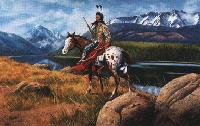
Quotes from Chief Joseph
The earth is our mother. She should not be disturbed by hoe or plough. We want only to subsist on what she freely gives us. Our fathers gave us many laws, which they had learned from their fathers. These laws were good. I have carried a heavy load on my back ever since I was a boy. I realized then that we could not hold our own with the white men. We were like deer. They were like grizzly bears. We had small country. Their country was large. We were contented to let things remain as the Great Spirit Chief made them. They were not, and would change the rivers and mountains if they did not suit them.Our fathers gave us many laws, which they had learned from their fathers. These laws were good. They told us to treat all people as they treated us; that we should never be the first to break a bargain; that is was a disgrace to tell a lie; that we should speak only the truth; that it was a shame for one man to take another his wife or his property without paying for it.
We were contented to let things remain as the Great Spirit made them.
Suppose a white man should come to me and say, Joseph, I like your horses. I want to buy them. I say to him, No, my horses suit me; I will not sell them. Then he goes to my neighbor and says, Pay me money, and I will sell you Josephís horses.
The white man returns to me and says, Joseph, I have bought your horses and you must let me have them. If we sold our lands to the government, this is the way they bought them.
I am not a child, I think for myself. No man can think for me.
If you tie a horse to a stake, do you expect him to grow fat? If you pen an Indian up on a small spot of earth, and compel him to stay there, he will not be contented, nor will he grow and prosper.
The earth and myself are of one mind.
We were taught to believe that the Great Spirit sees and hears everything, and that he never forgets, that hereafter he will give every man a spirit home according to his deserts; If he has been a good man, he will have a good home; if he has been a bad man, he will have a bad home.
This I believe, and all my people believe the same.
Good words do not last long unless they amount to something. Words do not pay for my dead people. They do not pay for my country, now overrun by white men. They do not protect my fatherís grave. They do not pay for all my horses and cattle.
Good words cannot give me back my children. Good words will not give my people good health and stop them from dying. Good words will not get my people a home where they can live in peace and take care of themselves.
I am tired of talk that comes to nothing It makes my heart sick when I remember all the good words and all the broken promises. There has been too much talking by men who had no right to talk.
It does not require many words to speak the truth.
We do not want churches because they will teach us to quarrel about God, as the Catholics and Protestants do. We do not want that. We may quarrel with men about things on earth, but we never quarrel about the Great Spirit.
I believe much trouble and blood would be saved if we opened our hearts more. I will tell you in my way how the Indian sees things. The white man has more words to tell you how they look to him, but is does not require many words to seek the truth.
Too many misinterpretations have been made... too many misunderstandings...
The Great Spirit Chief who rules above all will smile upon this land... and this time the Indian race is waiting and praying.
If the white man wants to live in peace with the Indian...we can live in peace. There need be no trouble. Treat all men alike.... give them all the same law. Give them all an even chance to live and grow. You might as well expect the rivers to run backward as that any man who is born a free man should be contented when penned up and denied liberty to go where he pleases. We only ask an even chance to live as other men live. We ask to be recognized as men. Let me be a free man...free to travel... free to stop...free to work...free to choose my own teachers...free to follow the religion of my Fathers...free to think and talk and act for myself."
Perhaps
you think the Creator sent you here
to dispose of us as you see fit.
If I thought you were sent by the Creator,
I might be induced to think you had a right to dispose of me.
Do not misunderstand me, but understand fully
with reference to my affection for the land.
I never said the land was mine to do with as I choose.
The one who has a right to dispose of it is the one who has created it.
I claim a right to live on my land
and accord you the privilege to return to yours.
Brother, we have listened to your talk coming from the father in
Washington,
and my people have called upon me to reply to you.
And in the winds which pass through these aged pines
we hear the moaning of their departed ghosts.
And if the voices of our people could have been heard,
that act would never have been done.
But alas, though they stood around,
they could neither be seen nor heard.
Their tears fell like dorps of rain.
I hear my voice in the depths of the forest,
but no answering voice comes back to me.
All is silent around me.
My words must therfore be few. I can say no more.
He is silent, for he has nothing to answer when the sun goes down.
More about Chief Joseph and Nespelem where he spent the remaining 19 years of his life on Colville Indian Reservation.
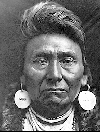
Among the Nez Perce a great respect is attributed to the deceased and every effort is extended to insure protection of Chief Joseph's grave.
In 1928, the descendents of the Wallowa Band and Joseph's descendents got together to talk over the matter of protecting Chief Joseph's grave. It was decided that it should be moved to the edge of Wallowa Lake. When the family had exhumed the body, they had discovered Joseph's skull had been removed. They had suspected as much because of some rumored reports about it having been on display somehwere.
To this day, no one seems to know where it is. Several family members remember some names and people and it may yet be possible to find out where the skull is and who took it.
While I was working at the Wallowa-Whitman Nat Forest, a group of people were wanting to purchase land immediately adjacent to Old Joseph's grave site. The intent was to develop condos and such as the area next to the lake is the most prime land anywhere in northeast Oregon. Since that time, many others have joined in and want to cash in on the development.
It is certainly an understatement on my part to say that the Wallowa is sacred to my family and descendents of the Wallowa Band Nez Perce. That land contains the spirit of our people. Now it seems everybody wants to cash in on the Nez Perce history. When I think about it, I just get angry and I want to bite my tongue off for fear of saying bad things!
If people knew the true reasons why the whites wanted the Wallowa and pressured the government for the removal of the Nez Perce then they would understand the greed that now grips them.
Yox Kalo'
(That's all)
Phil E. Minthorn
Descendent of Chief Joseph
Cayuse/Nez Perce
Wallowa Band
![]() Return to Indigenous Peoples' Literature
Return to Indigenous Peoples' Literature
Compiled by: Glenn Welker
ghwelker@gmx.com
This site has been accessed 10,000,000 times since February 8, 1996.
